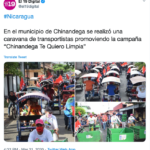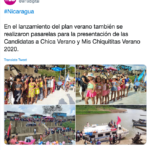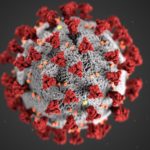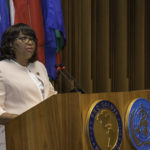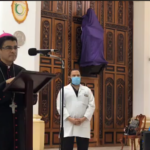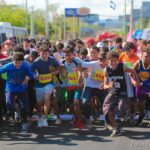A week has passed since Nicaraguan Vice President Rosario Murillo reported the first case of COVID19 in the country. The government’s message remains unchanged. Authorities consistently downplay the threat, while insisting that the one of the poorest in Latin America is well prepared for the inevitable pandemic.
There is no need to panic.
All people need to do is wash their hands, stop touching their face, practice proper respiratory hygiene, and keep social distance. However, other measures, like school closures, curfews, avoiding crowds, allowing testing in private hospitals, or establishing quarantines are completely ignored, actively discouraged, or mocked as hysteria, pandering, and fake news.
The Ortega Murillo Propaganda Machine has been repurposed accordingly. On the one hand, government-controlled media produce and disseminate health education messages that are comparable to campaigns carried out around the world. For example, Nicaraguan government media published this short video on hand washing, as part of a campaign titled Prevention is the Best Cure.
For comparison, here is a WHO informational video, detailing steps that people can take to prevent the spread of COVID19.
At the same time, the Ortega-Murillo government hangs on to their bizarre, bipolar response, which undermines the effectiveness of their health communication campaigns. Authorities still refuse to promote social distancing as a preventative measure, perhaps trusting that since community spread has yet to be reported, it will not happen at all.
Instead, the government continues orchestrating and promoting large gatherings, festivals, and other activities that increase the risk of widespread community contagion. For instance, festivals and pageants went on as planned on the weekend of March 21-22
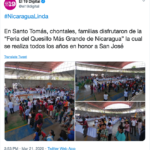
The same weekend, the government sent out health brigades to do house-to-house visits. The purpose was to educate people on the prevention of COVID19. The video below was produced to showcase the strategy. No one seems to be mindful of social distance.
Perhaps they don’t feel the need to model it at all.
The Ministry of Health (MINSA) holds a briefing twice a day, but a large portion of the population doubts that MINSA can handle a potential health crisis. According to a recent CID/GALLUP poll, 78% of Nicaraguans don’t think MINSA is up to the challenge.
Public distrust is high, and it could be due in part to MINSA’s secrecy in withholding crucial information.
Very little is known about the number of wards, beds, and respirators available to serve a population of 6 million. One estimate, by investigative reporter Wilfredo Miranda, suggests that there could be about 160 respirators in the entire country, but MINSA has yet to cough up an actual number.
Instead, Minister for Health Carolina Dávila and the MINSA’s Secretary General Carlos Sáenz have become a familiar tag team. Their role is to reassure everyone that “Nicaragua has 19 hospitals” ready to handle serious COVID19 cases, and that the country’s “community health” model can efficiently detect, diagnose, monitor, and refer patients to the appropriate health unit.
One of these units is the César Amador Hospital, in Matagalpa. In 2012, the municipality of Matagalpa had a population of 150 thousand. The COVID19 isolation ward has 46 beds, according to hospital’s director, Henry Dávila. He indicated that his hospital had prepared after considering the behavior that the disease has displayed in other regions of the world. “We decided on the number of beds, after considering the behavioral pattern the disease has followed, which we expect will be repeated in our country,” said Dávila.
The Imperial College of London estimates that the Ro for COVID19, that is the number of cases that one infected person can cause during the period of transmission, is between 1.5 and 3.5. That means that one person can infect 1-to-3 people on average.
Forty-six beds might not be enough.
As of this writing, MINSA is only entity in the country that can perform tests for COVID19, but no one knows how many tests have actually been performed, at least not officially. MINSA Secretary General Sáenz said the number might be around 200, during and interview granted to Channel 10 News, but MINSA doesn’t publish the data anywhere.
The information vacuum is to no one’s benefit, yet it continues, as the Ortega-Murillo government tries to control COVID19 messaging. MINSA press briefings, for example, are only open to government media outlets, where no one asks questions.
The other source of information and guidance on COVID19 is Vice President Murillo’s daily address. Since announcing the first case, Murillo’s message has been more akin to a sermon than a briefing. During her message on March 26, for example, Murillo recited St. Francis’ Peace Prayer, praised God, thanked God, and expressed her “infinite admiration for Pope Francis”.
But the most important part of today’s message was Murillo’s attempt to put COVID19 into perspective, by downplaying the seriousness of the pandemic. Other illnesses and social issues are far deadlier
According to the United Nations, 30,503 Persons die every day due to malnutrition. 8,500 are Children. There are also 22,401 deaths due to Cancer. […] Children younger than 5 die of curable diseases. […] Smoking kills 22,224 people per day, according to the WHO, and we also have alcoholism. 8,333 are killed daily because of alcoholism. […]
[…] We must keep these data in mind, because we are working for a better world.
It is likely that this will become a talking point for government surrogates.
To date, MINSA has reported two cases and one death.
President Daniel Ortega has yet to address the Nicaraguan people about COVID19. His last public appearance was on March 12, when he participated in a virtual meeting to discuss COVID19.
